Abstract
1. In the isolated perfused, noradrenaline (NA)-constricted mesenteric arteries of the rat, acetylcholine (0.003-1 nmol), histamine (0.01-10 nmol) and the calcium ionophore A23187 (0.01-1 nmol), caused endothelium-dependent vasodilatation while the vasodilatation by the K+ channel activator BRL 34915 (0.1-1 nmol) was independent of endothelium. 2. The guanylate cyclase inhibitor, methylene blue at 10 microM did not inhibit the action of any of the vasodilators but at 50 microM reduced the vasodilator effect of acetylcholine (ACh), histamine and A23187. 3. Infusion of ouabain or perfusion with K(+)-free or excess K+ (50 mM) Krebs solution reduced the vasodilator effect of ACh, histamine and A23187, suggesting the action of these agents involves, at least in part, activation of Na+/K(+)-ATPase. The vasodilator effect of BRL 34915 was not affected by ouabain, but abolished during perfusion with Krebs solution containing excess K+ or depleted of K+. 4. Five structurally distinct K+ channel blockers (apamin, crude scorpion venom, procaine, quinidine and tetraethylammonium) attenuated the vasodilator effect of ACh, histamine and A23187. The K+ channel blockers, except apamin and crude scorpion venom, also inhibited the vasodilatation produced by BRL 34915. 5. The vasodilator effect of ACh, histamine or A23187 was not altered in mesenteric vessels of pertussis toxin-treated rats, suggesting that the K+ channels associated with the endothelium-dependent vasodilator effect of these agents are either not coupled to G-proteins or are coupled to G-proteins that are insensitive to pertussis toxin.(ABSTRACT TRUNCATED AT 250 WORDS)
Full text
PDF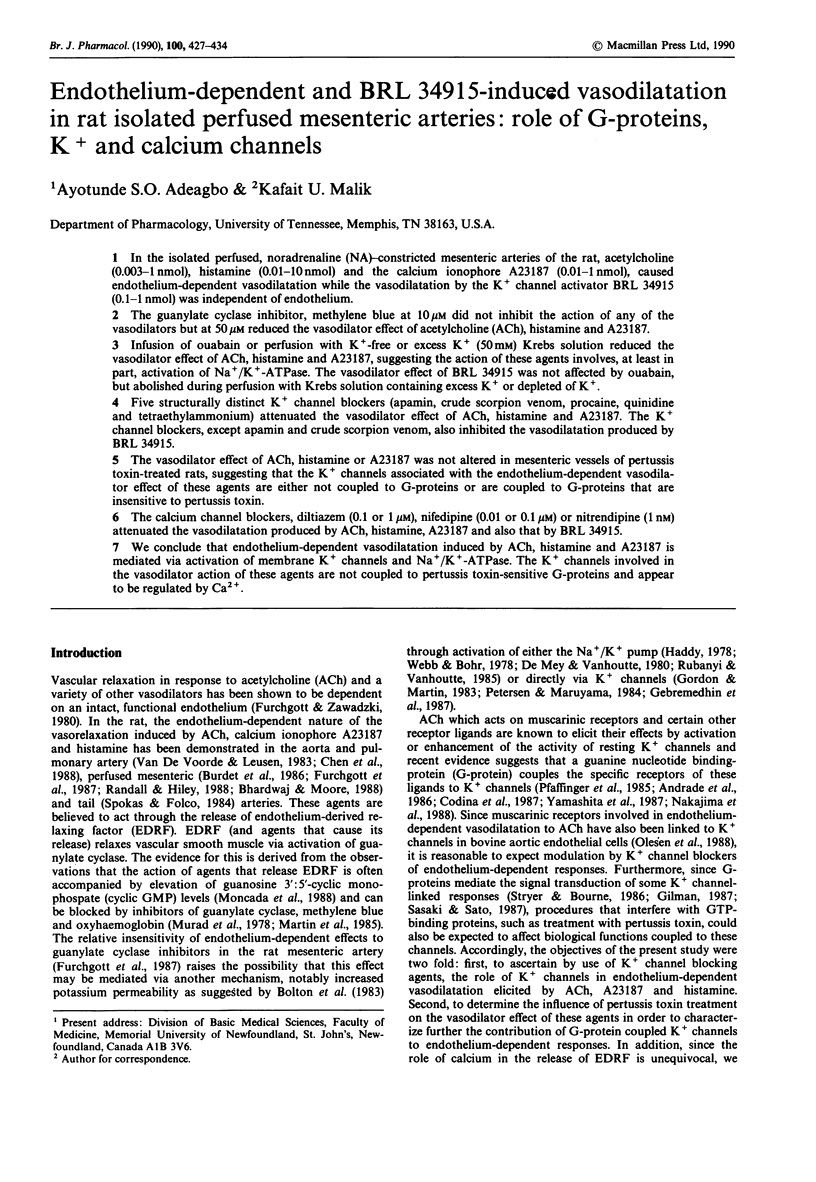

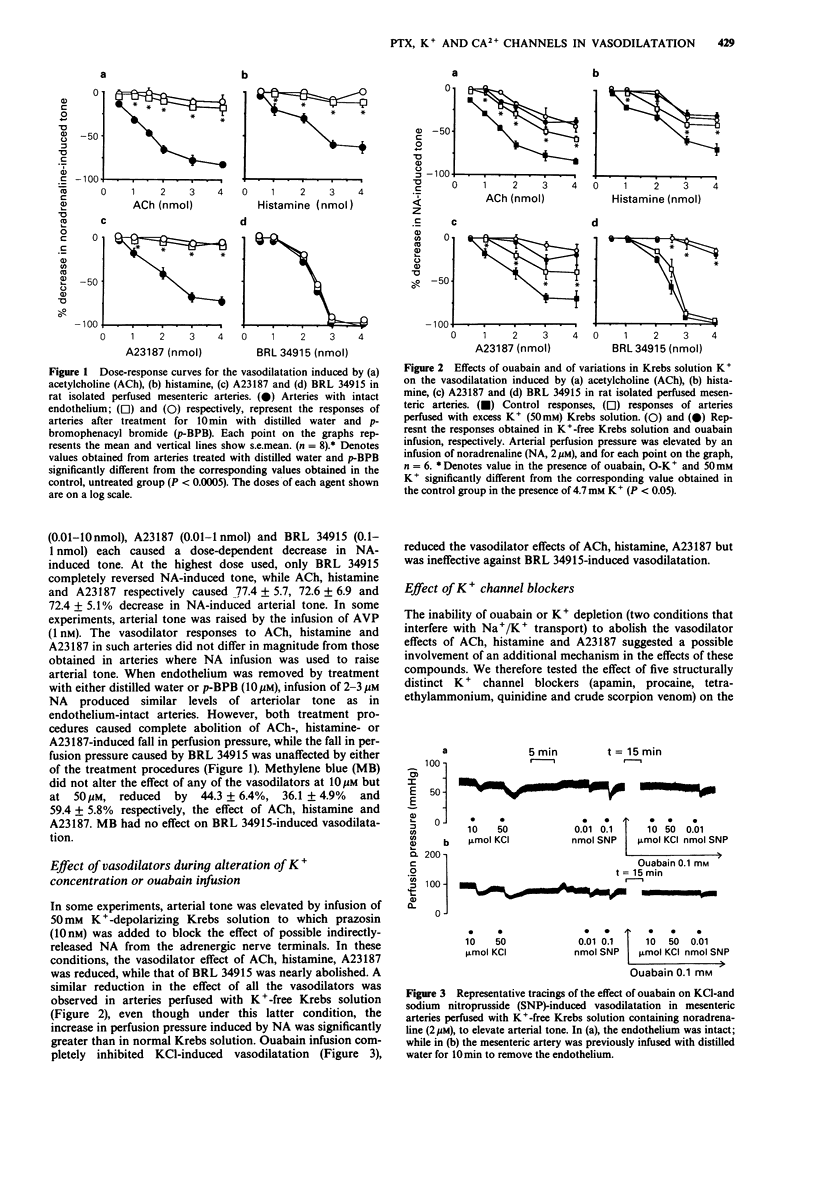
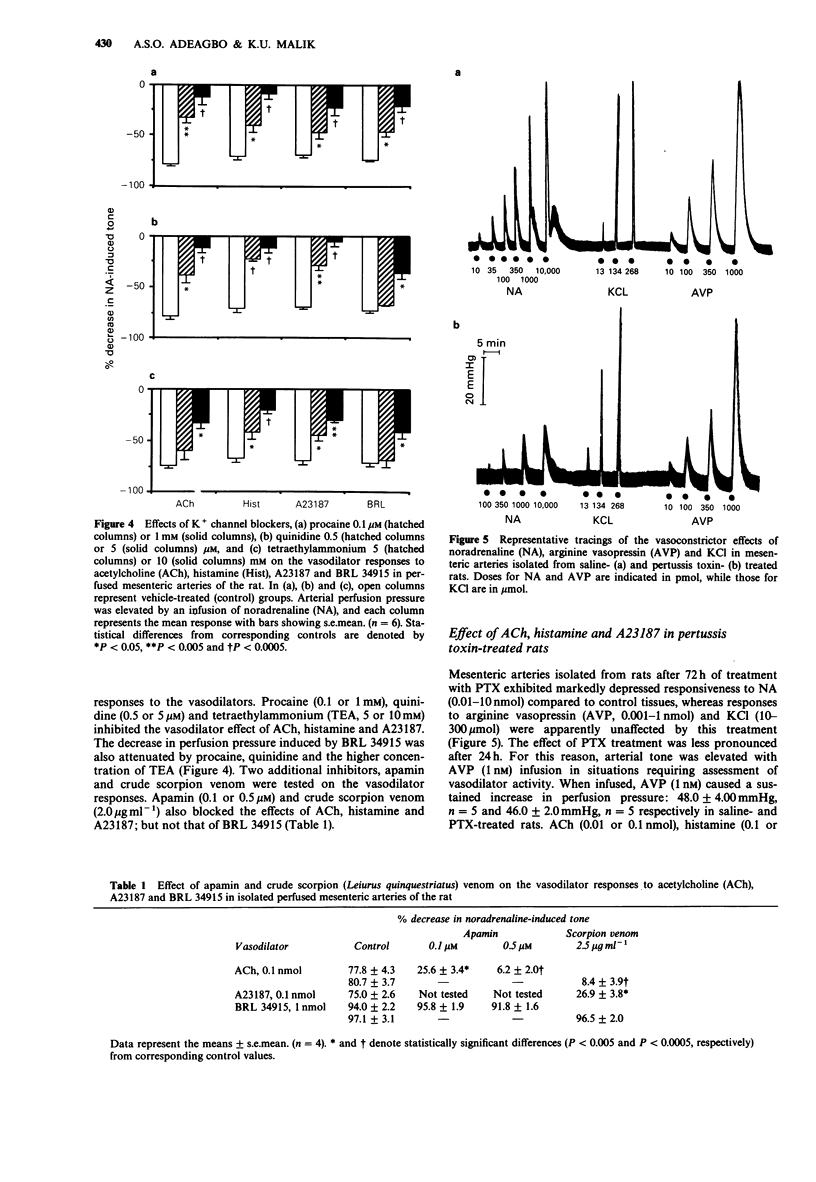
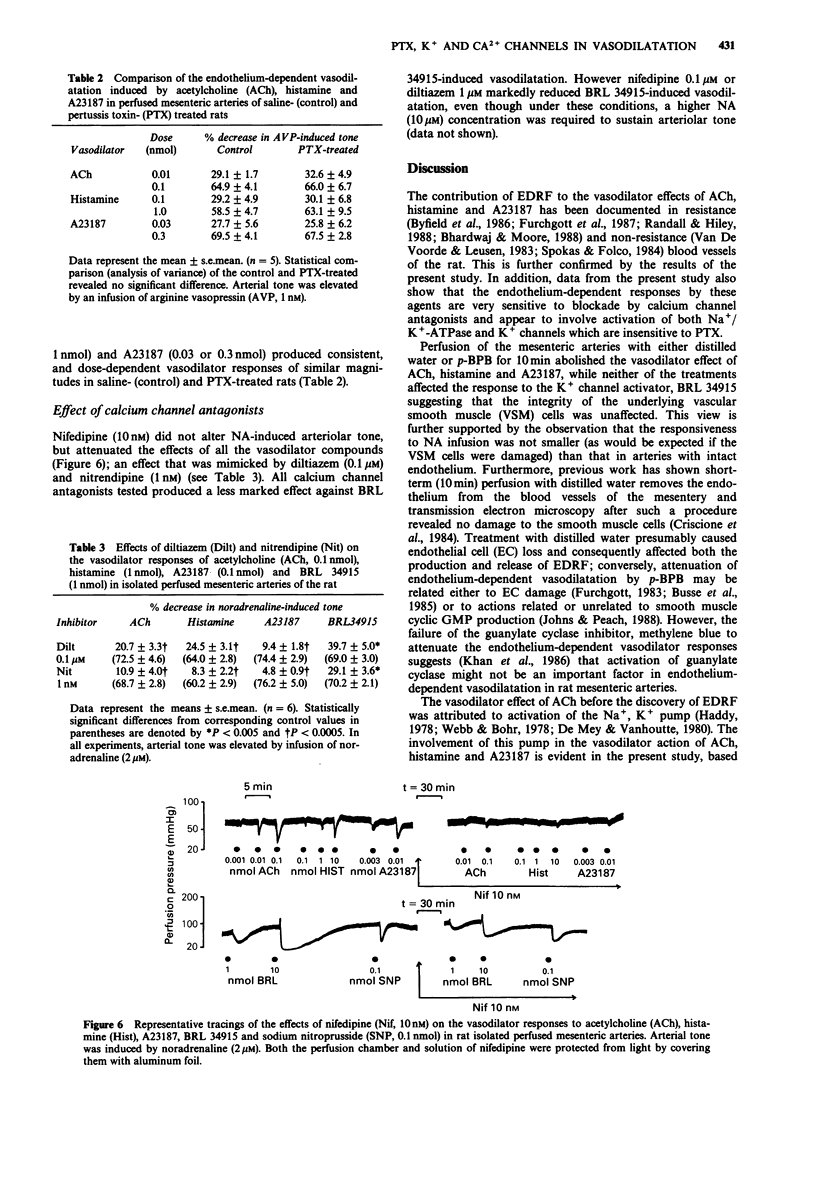
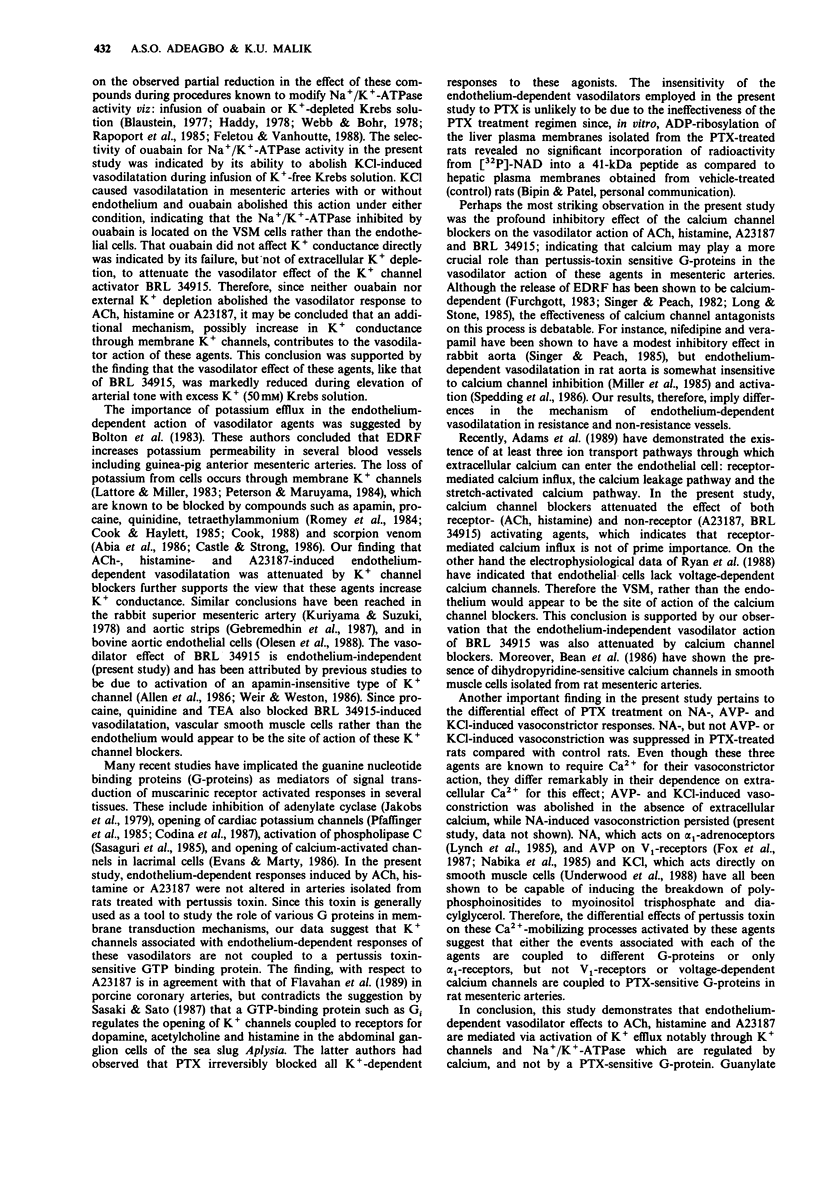
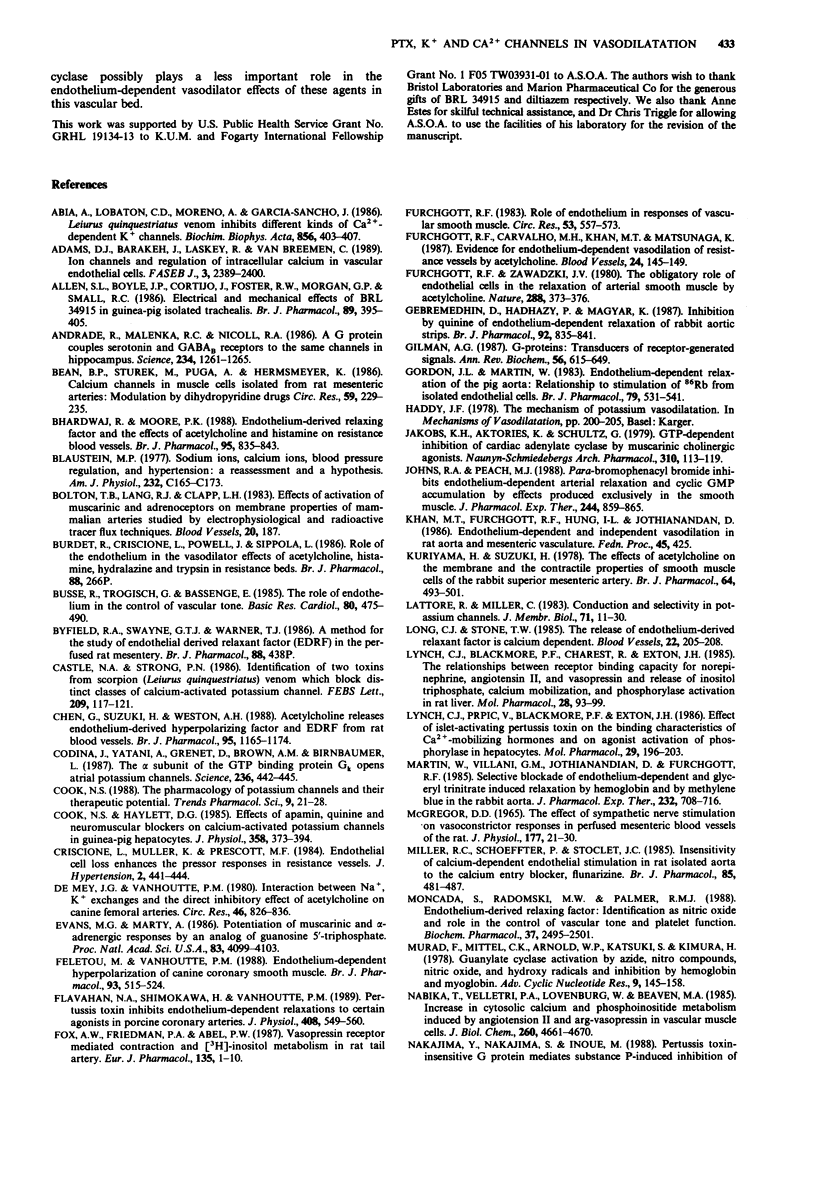

Selected References
These references are in PubMed. This may not be the complete list of references from this article.
- Abia A., Lobatón C. D., Moreno A., García-Sancho J. Leiurus quinquestriatus venom inhibits different kinds of Ca2+-dependent K+ channels. Biochim Biophys Acta. 1986 Apr 14;856(2):403–407. doi: 10.1016/0005-2736(86)90054-4. [DOI] [PubMed] [Google Scholar]
- Adams D. J., Barakeh J., Laskey R., Van Breemen C. Ion channels and regulation of intracellular calcium in vascular endothelial cells. FASEB J. 1989 Oct;3(12):2389–2400. doi: 10.1096/fasebj.3.12.2477294. [DOI] [PubMed] [Google Scholar]
- Allen S. L., Boyle J. P., Cortijo J., Foster R. W., Morgan G. P., Small R. C. Electrical and mechanical effects of BRL34915 in guinea-pig isolated trachealis. Br J Pharmacol. 1986 Oct;89(2):395–405. doi: 10.1111/j.1476-5381.1986.tb10273.x. [DOI] [PMC free article] [PubMed] [Google Scholar]
- Andrade R., Malenka R. C., Nicoll R. A. A G protein couples serotonin and GABAB receptors to the same channels in hippocampus. Science. 1986 Dec 5;234(4781):1261–1265. doi: 10.1126/science.2430334. [DOI] [PubMed] [Google Scholar]
- Bean B. P., Sturek M., Puga A., Hermsmeyer K. Calcium channels in muscle cells isolated from rat mesenteric arteries: modulation by dihydropyridine drugs. Circ Res. 1986 Aug;59(2):229–235. doi: 10.1161/01.res.59.2.229. [DOI] [PubMed] [Google Scholar]
- Bhardwaj R., Moore P. K. Endothelium-derived relaxing factor and the effects of acetylcholine and histamine on resistance blood vessels. Br J Pharmacol. 1988 Nov;95(3):835–843. doi: 10.1111/j.1476-5381.1988.tb11712.x. [DOI] [PMC free article] [PubMed] [Google Scholar]
- Blaustein M. P. Sodium ions, calcium ions, blood pressure regulation, and hypertension: a reassessment and a hypothesis. Am J Physiol. 1977 May;232(5):C165–C173. doi: 10.1152/ajpcell.1977.232.5.C165. [DOI] [PubMed] [Google Scholar]
- Busse R., Trogisch G., Bassenge E. The role of endothelium in the control of vascular tone. Basic Res Cardiol. 1985 Sep-Oct;80(5):475–490. doi: 10.1007/BF01907912. [DOI] [PubMed] [Google Scholar]
- Castle N. A., Strong P. N. Identification of two toxins from scorpion (Leiurus quinquestriatus) venom which block distinct classes of calcium-activated potassium channel. FEBS Lett. 1986 Dec 1;209(1):117–121. doi: 10.1016/0014-5793(86)81095-x. [DOI] [PubMed] [Google Scholar]
- Chen G., Suzuki H., Weston A. H. Acetylcholine releases endothelium-derived hyperpolarizing factor and EDRF from rat blood vessels. Br J Pharmacol. 1988 Dec;95(4):1165–1174. doi: 10.1111/j.1476-5381.1988.tb11752.x. [DOI] [PMC free article] [PubMed] [Google Scholar]
- Codina J., Yatani A., Grenet D., Brown A. M., Birnbaumer L. The alpha subunit of the GTP binding protein Gk opens atrial potassium channels. Science. 1987 Apr 24;236(4800):442–445. doi: 10.1126/science.2436299. [DOI] [PubMed] [Google Scholar]
- Cook N. S., Haylett D. G. Effects of apamin, quinine and neuromuscular blockers on calcium-activated potassium channels in guinea-pig hepatocytes. J Physiol. 1985 Jan;358:373–394. doi: 10.1113/jphysiol.1985.sp015556. [DOI] [PMC free article] [PubMed] [Google Scholar]
- Cook N. S. The pharmacology of potassium channels and their therapeutic potential. Trends Pharmacol Sci. 1988 Jan;9(1):21–28. doi: 10.1016/0165-6147(88)90238-6. [DOI] [PubMed] [Google Scholar]
- De Mey J. G., Vanhoutte P. M. Interaction between Na+,K+ exchanges and the direct inhibitory effect of acetylcholine on canine femoral arteries. Circ Res. 1980 Jun;46(6):826–836. doi: 10.1161/01.res.46.6.826. [DOI] [PubMed] [Google Scholar]
- Evans M. G., Marty A. Potentiation of muscarinic and alpha-adrenergic responses by an analogue of guanosine 5'-triphosphate. Proc Natl Acad Sci U S A. 1986 Jun;83(11):4099–4103. doi: 10.1073/pnas.83.11.4099. [DOI] [PMC free article] [PubMed] [Google Scholar]
- Feletou M., Vanhoutte P. M. Endothelium-dependent hyperpolarization of canine coronary smooth muscle. Br J Pharmacol. 1988 Mar;93(3):515–524. doi: 10.1111/j.1476-5381.1988.tb10306.x. [DOI] [PMC free article] [PubMed] [Google Scholar]
- Flavahan N. A., Shimokawa H., Vanhoutte P. M. Pertussis toxin inhibits endothelium-dependent relaxations to certain agonists in porcine coronary arteries. J Physiol. 1989 Jan;408:549–560. doi: 10.1113/jphysiol.1989.sp017475. [DOI] [PMC free article] [PubMed] [Google Scholar]
- Fox A. W., Friedman P. A., Abel P. W. Vasopressin receptor mediated contraction and [3H]inositol metabolism in rat tail artery. Eur J Pharmacol. 1987 Mar 3;135(1):1–10. doi: 10.1016/0014-2999(87)90751-5. [DOI] [PubMed] [Google Scholar]
- Furchgott R. F., Carvalho M. H., Khan M. T., Matsunaga K. Evidence for endothelium-dependent vasodilation of resistance vessels by acetylcholine. Blood Vessels. 1987;24(3):145–149. doi: 10.1159/000158689. [DOI] [PubMed] [Google Scholar]
- Furchgott R. F. Role of endothelium in responses of vascular smooth muscle. Circ Res. 1983 Nov;53(5):557–573. doi: 10.1161/01.res.53.5.557. [DOI] [PubMed] [Google Scholar]
- Furchgott R. F., Zawadzki J. V. The obligatory role of endothelial cells in the relaxation of arterial smooth muscle by acetylcholine. Nature. 1980 Nov 27;288(5789):373–376. doi: 10.1038/288373a0. [DOI] [PubMed] [Google Scholar]
- Gebremedhin D., Hadházy P., Magyar K. Inhibition by quinine of endothelium-dependent relaxation of rabbit aortic strips. Br J Pharmacol. 1987 Dec;92(4):835–841. doi: 10.1111/j.1476-5381.1987.tb11388.x. [DOI] [PMC free article] [PubMed] [Google Scholar]
- Gilman A. G. G proteins: transducers of receptor-generated signals. Annu Rev Biochem. 1987;56:615–649. doi: 10.1146/annurev.bi.56.070187.003151. [DOI] [PubMed] [Google Scholar]
- Gordon J. L., Martin W. Endothelium-dependent relaxation of the pig aorta: relationship to stimulation of 86Rb efflux from isolated endothelial cells. Br J Pharmacol. 1983 Jun;79(2):531–541. doi: 10.1111/j.1476-5381.1983.tb11028.x. [DOI] [PMC free article] [PubMed] [Google Scholar]
- Jakobs K. H., Aktories K., Schultz G. GTP-dependent inhibition of cardiac adenylate cyclase by muscarinic cholinergic agonists. Naunyn Schmiedebergs Arch Pharmacol. 1979 Dec;310(2):113–119. doi: 10.1007/BF00500275. [DOI] [PubMed] [Google Scholar]
- Johns R. A., Peach M. J. Para-bromophenacyl bromide inhibits endothelium-dependent arterial relaxation and cyclic GMP accumulation by effects produced exclusively in the smooth muscle. J Pharmacol Exp Ther. 1988 Mar;244(3):859–865. [PubMed] [Google Scholar]
- Kuriyama H., Suzuki H. The effects of acetylcholine on the membrane and contractile properties of smooth muscle cells of the rabbit superior mesenteric artery. Br J Pharmacol. 1978 Dec;64(4):493–501. doi: 10.1111/j.1476-5381.1978.tb17310.x. [DOI] [PMC free article] [PubMed] [Google Scholar]
- Latorre R., Miller C. Conduction and selectivity in potassium channels. J Membr Biol. 1983;71(1-2):11–30. doi: 10.1007/BF01870671. [DOI] [PubMed] [Google Scholar]
- Long C. J., Stone T. W. The release of endothelium-derived relaxant factor is calcium dependent. Blood Vessels. 1985;22(4):205–208. doi: 10.1159/000158602. [DOI] [PubMed] [Google Scholar]
- Lynch C. J., Blackmore P. F., Charest R., Exton J. H. The relationships between receptor binding capacity for norepinephrine, angiotensin II, and vasopressin and release of inositol trisphosphate, Ca2+ mobilization, and phosphorylase activation in rat liver. Mol Pharmacol. 1985 Aug;28(2):93–99. [PubMed] [Google Scholar]
- Lynch C. J., Prpic V., Blackmore P. F., Exton J. H. Effect of islet-activating pertussis toxin on the binding characteristics of Ca2+-mobilizing hormones and on agonist activation of phosphorylase in hepatocytes. Mol Pharmacol. 1986 Feb;29(2):196–203. [PubMed] [Google Scholar]
- MCGREGOR D. D. THE EFFECT OF SYMPATHETIC NERVE STIMULATION OF VASOCONSTRICTOR RESPONSES IN PERFUSED MESENTERIC BLOOD VESSELS OF THE RAT. J Physiol. 1965 Mar;177:21–30. doi: 10.1113/jphysiol.1965.sp007572. [DOI] [PMC free article] [PubMed] [Google Scholar]
- Martin W., Villani G. M., Jothianandan D., Furchgott R. F. Selective blockade of endothelium-dependent and glyceryl trinitrate-induced relaxation by hemoglobin and by methylene blue in the rabbit aorta. J Pharmacol Exp Ther. 1985 Mar;232(3):708–716. [PubMed] [Google Scholar]
- Miller R. C., Schoeffter P., Stoclet J. C. Insensitivity of calcium-dependent endothelial stimulation in rat isolated aorta to the calcium entry blocker, flunarizine. Br J Pharmacol. 1985 Jun;85(2):481–487. doi: 10.1111/j.1476-5381.1985.tb08885.x. [DOI] [PMC free article] [PubMed] [Google Scholar]
- Moncada S., Radomski M. W., Palmer R. M. Endothelium-derived relaxing factor. Identification as nitric oxide and role in the control of vascular tone and platelet function. Biochem Pharmacol. 1988 Jul 1;37(13):2495–2501. doi: 10.1016/0006-2952(88)90236-5. [DOI] [PubMed] [Google Scholar]
- Murad F., Mittal C. K., Arnold W. P., Katsuki S., Kimura H. Guanylate cyclase: activation by azide, nitro compounds, nitric oxide, and hydroxyl radical and inhibition by hemoglobin and myoglobin. Adv Cyclic Nucleotide Res. 1978;9:145–158. [PubMed] [Google Scholar]
- Nabika T., Velletri P. A., Lovenberg W., Beaven M. A. Increase in cytosolic calcium and phosphoinositide metabolism induced by angiotensin II and [Arg]vasopressin in vascular smooth muscle cells. J Biol Chem. 1985 Apr 25;260(8):4661–4670. [PubMed] [Google Scholar]
- Nakajima Y., Nakajima S., Inoue M. Pertussis toxin-insensitive G protein mediates substance P-induced inhibition of potassium channels in brain neurons. Proc Natl Acad Sci U S A. 1988 May;85(10):3643–3647. doi: 10.1073/pnas.85.10.3643. [DOI] [PMC free article] [PubMed] [Google Scholar]
- Olesen S. P., Davies P. F., Clapham D. E. Muscarinic-activated K+ current in bovine aortic endothelial cells. Circ Res. 1988 Jun;62(6):1059–1064. doi: 10.1161/01.res.62.6.1059. [DOI] [PubMed] [Google Scholar]
- Petersen O. H., Maruyama Y. Calcium-activated potassium channels and their role in secretion. Nature. 1984 Feb 23;307(5953):693–696. doi: 10.1038/307693a0. [DOI] [PubMed] [Google Scholar]
- Pfaffinger P. J., Martin J. M., Hunter D. D., Nathanson N. M., Hille B. GTP-binding proteins couple cardiac muscarinic receptors to a K channel. Nature. 1985 Oct 10;317(6037):536–538. doi: 10.1038/317536a0. [DOI] [PubMed] [Google Scholar]
- Randall M. D., Hiley C. R. Effect of phenobarbitone pretreatment upon endothelium-dependent relaxation to acetylcholine in rat superior mesenteric arterial bed. Br J Pharmacol. 1988 Jul;94(3):977–983. doi: 10.1111/j.1476-5381.1988.tb11612.x. [DOI] [PMC free article] [PubMed] [Google Scholar]
- Rapoport R. M., Schwartz K., Murad F. Effects of Na+,K+-pump inhibitors and membrane depolarizing agents on acetylcholine-induced endothelium-dependent relaxation and cyclic GMP accumulation in rat aorta. Eur J Pharmacol. 1985 Apr 2;110(2):203–209. doi: 10.1016/0014-2999(85)90212-2. [DOI] [PubMed] [Google Scholar]
- Romey G., Hugues M., Schmid-Antomarchi H., Lazdunski M. Apamin: a specific toxin to study a class of Ca2+-dependent K+ channels. J Physiol (Paris) 1984;79(4):259–264. [PubMed] [Google Scholar]
- Rubanyi G. M., Vanhoutte P. M. Ouabain inhibits endothelium-dependent relaxations to arachidonic acid in canine coronary arteries. J Pharmacol Exp Ther. 1985 Oct;235(1):81–86. [PubMed] [Google Scholar]
- Ryan U. S., Johns A., Van Breemen C. Role of calcium in receptor-mediated endothelial cell responses. Chest. 1988 Mar;93(3 Suppl):105S–109S. doi: 10.1378/chest.93.3_supplement.105s. [DOI] [PubMed] [Google Scholar]
- Sasaguri T., Hirata M., Kuriyama H. Dependence on Ca2+ of the activities of phosphatidylinositol 4,5-bisphosphate phosphodiesterase and inositol 1,4,5-trisphosphate phosphatase in smooth muscles of the porcine coronary artery. Biochem J. 1985 Nov 1;231(3):497–503. doi: 10.1042/bj2310497. [DOI] [PMC free article] [PubMed] [Google Scholar]
- Sasaki K., Sato M. A single GTP-binding protein regulates K+-channels coupled with dopamine, histamine and acetylcholine receptors. Nature. 1987 Jan 15;325(6101):259–262. doi: 10.1038/325259a0. [DOI] [PubMed] [Google Scholar]
- Singer H. A., Peach M. J. Calcium- and endothelial-mediated vascular smooth muscle relaxation in rabbit aorta. Hypertension. 1982 May-Jun;4(3 Pt 2):19–25. [PubMed] [Google Scholar]
- Spedding M., Schini V., Schoeffter P., Miller R. C. Calcium channel activation does not increase release of endothelial-derived relaxant factors (EDRF) in rat aorta although tonic release of EDRF may modulate calcium channel activity in smooth muscle. J Cardiovasc Pharmacol. 1986 Nov-Dec;8(6):1130–1137. doi: 10.1097/00005344-198611000-00006. [DOI] [PubMed] [Google Scholar]
- Spokas E. G., Folco G. C. Intima-related vasodilatation of the perfused rat caudal artery. Eur J Pharmacol. 1984 Apr 20;100(2):211–217. doi: 10.1016/0014-2999(84)90225-5. [DOI] [PubMed] [Google Scholar]
- Stryer L., Bourne H. R. G proteins: a family of signal transducers. Annu Rev Cell Biol. 1986;2:391–419. doi: 10.1146/annurev.cb.02.110186.002135. [DOI] [PubMed] [Google Scholar]
- Underwood R. H., Greeley R., Glennon E. T., Menachery A. I., Braley L. M., Williams G. H. Mass determination of polyphosphoinositides and inositol triphosphate in rat adrenal glomerulosa cells with a microspectrophotometric method. Endocrinology. 1988 Jul;123(1):211–219. doi: 10.1210/endo-123-1-211. [DOI] [PubMed] [Google Scholar]
- Van de Voorde J., Leusen I. Role of the endothelium in the vasodilator response of rat thoracic aorta to histamine. Eur J Pharmacol. 1983 Jan 28;87(1):113–120. doi: 10.1016/0014-2999(83)90056-0. [DOI] [PubMed] [Google Scholar]
- Webb R. C., Bohr D. F. Potassium-induced relaxation as an indicator of Na+-K+ ATPase activity in vascular smooth muscle. Blood Vessels. 1978;15(1-3):198–207. doi: 10.1159/000158166. [DOI] [PubMed] [Google Scholar]
- Weir S. W., Weston A. H. Effect of apamin on responses to BRL 34915, nicorandil and other relaxants in the guinea-pig taenia caeci. Br J Pharmacol. 1986 May;88(1):113–120. doi: 10.1111/j.1476-5381.1986.tb09477.x. [DOI] [PMC free article] [PubMed] [Google Scholar]
- Yamashita N., Kojima I., Shibuya N., Ogata E. Pertussis toxin inhibits somatostatin-induced K+ conductance in human pituitary tumor cells. Am J Physiol. 1987 Jul;253(1 Pt 1):E28–E32. doi: 10.1152/ajpendo.1987.253.1.E28. [DOI] [PubMed] [Google Scholar]


